Through the Featured Chess Set project, the World Chess Hall of Fame showcases a variety of chess sets throughout the year. These include highlights from our own collection as well as chess sets owned by friends and chess lovers who have special stories to accompany their sets.
December
December’s Featured Chess Set is part of the collection of the World Chess Hall of Fame (WCHOF). Since its creation in 1986, the WCHOF has endeavored to highlight the history and cultural significance of the game of chess. The WCHOF’s collection is diverse and includes sets once owned by legendary players, mass-produced sets with lively pop culture themes, antique ivory sets, travel sets, as well as chess computers. Through these artifacts, the WCHOF illustrates how chess has evolved through its over 1500-year history. This set is part of the museum’s permanent collection.
December’s Christmas chess set was created by Turkish artist Engin Calisir. A chess player himself, Calisir wanted to create a set perfect for the holiday season. The board is decorated in classic holiday colors with the back square pieces slightly raised. Santa Claus is the king and the queen is not Mrs. Claus but rather the Snow Princess. The rook resembles Santa stuck in the chimney flue. The knight is a jolly snowman and the bishop a snow covered pine tree. Lastly, pawns are adorable reindeer, waiting for Santa.












November
November’s Featured Chess Set is part of the collection of the World Chess Hall of Fame (WCHOF). Since its creation in 1986, the WCHOF has endeavored to highlight the history and cultural significance of the game of chess. The WCHOF’s collection is diverse and includes sets once owned by legendary players, mass-produced sets with lively pop culture themes, antique ivory sets, travel sets, as well as chess computers. Through these artifacts, the WCHOF illustrates how chess has evolved through its over 1500-year history. This set is part of the museum’s permanent collection.
This month’s chess set is a 3D printed alcohol bottle themed chess set. 3D printing allows makers to create sets with varied and imaginative themes, from characters from television and movies to festive holiday sets. Both sides of the chess set depict the pawns as beer cans, rooks as whisky, knights as brandy, bishops as vodka, the queen as champagne, and the king as the shape of a whiskey bottle. The face of each bottle has the inscription of the designated chess piece while the knight, bishop, and king states the type of alcohol. The printed bottles rest on coasters that are the same color as the chess piece.
KING: Johnnie Walker Blue Label, Whiskey
QUEEN: Moët & Chandon, Champagne
BISHOP: Gray Goose, Vodka
ROOK: Jack Daniel's, Tennessee Whiskey
KNIGHT: Pinch, Scotch Whiskey
PAWN: Heineken, Beer
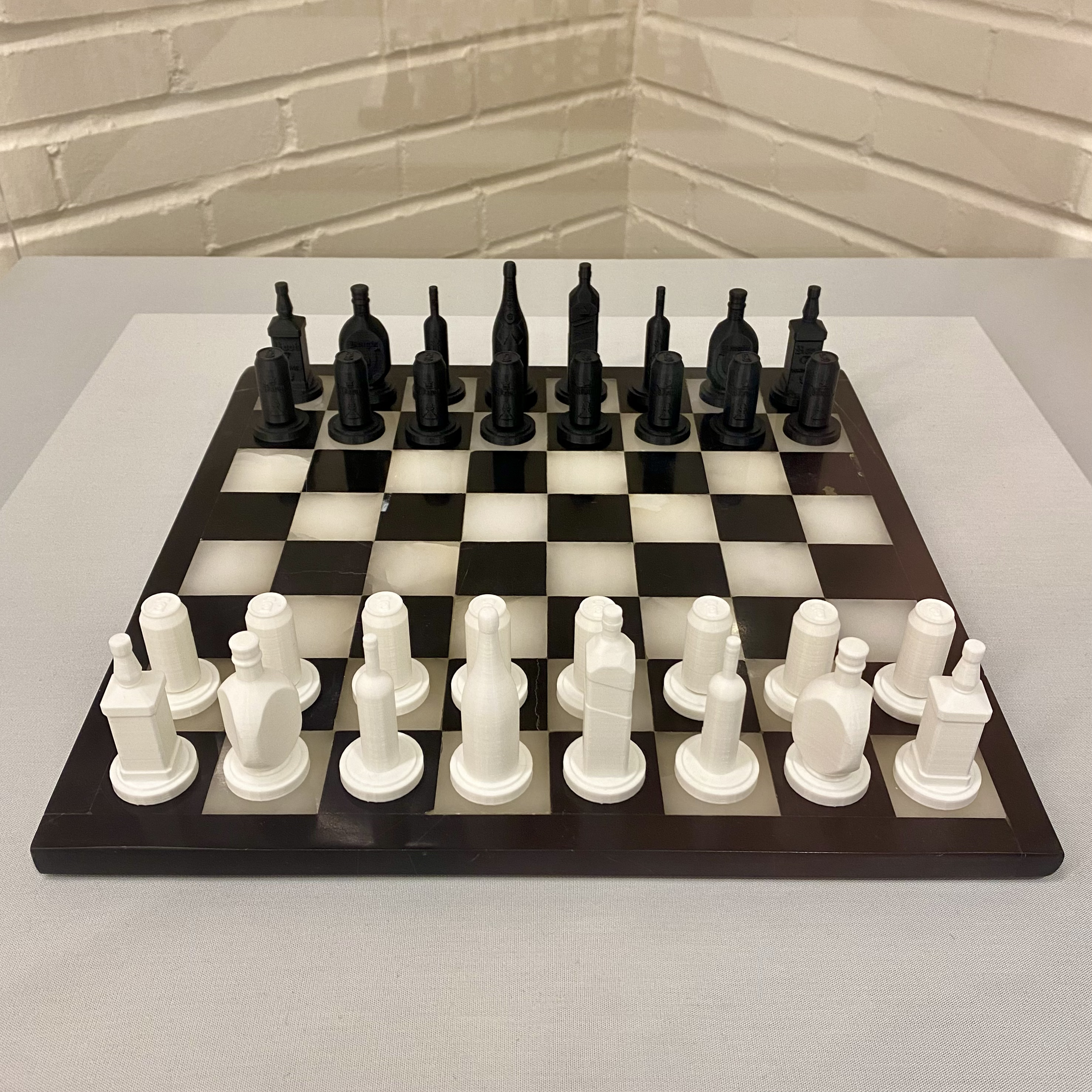

October
October’s Featured Chess Set is part of the collection of the World Chess Hall of Fame (WCHOF). Since its creation in 1986, the WCHOF has endeavored to highlight the history and cultural significance of the game of chess. The WCHOF’s collection is diverse and includes sets once owned by legendary players, mass-produced sets with lively pop culture themes, antique ivory sets, travel sets, as well as chess computers. Through these artifacts, the WCHOF illustrates how chess has evolved through its over 1500-year history. This set is part of the museum’s permanent collection.
This month’s featured chess set is 3D printed, and it features spooky Halloween symbols. Among them are skulls, ghosts, and cats resting atop smiling jack o'lanterns. 3D printing allows makers to create sets with varied and imaginative themes, from characters from television and movies to festive holiday sets.









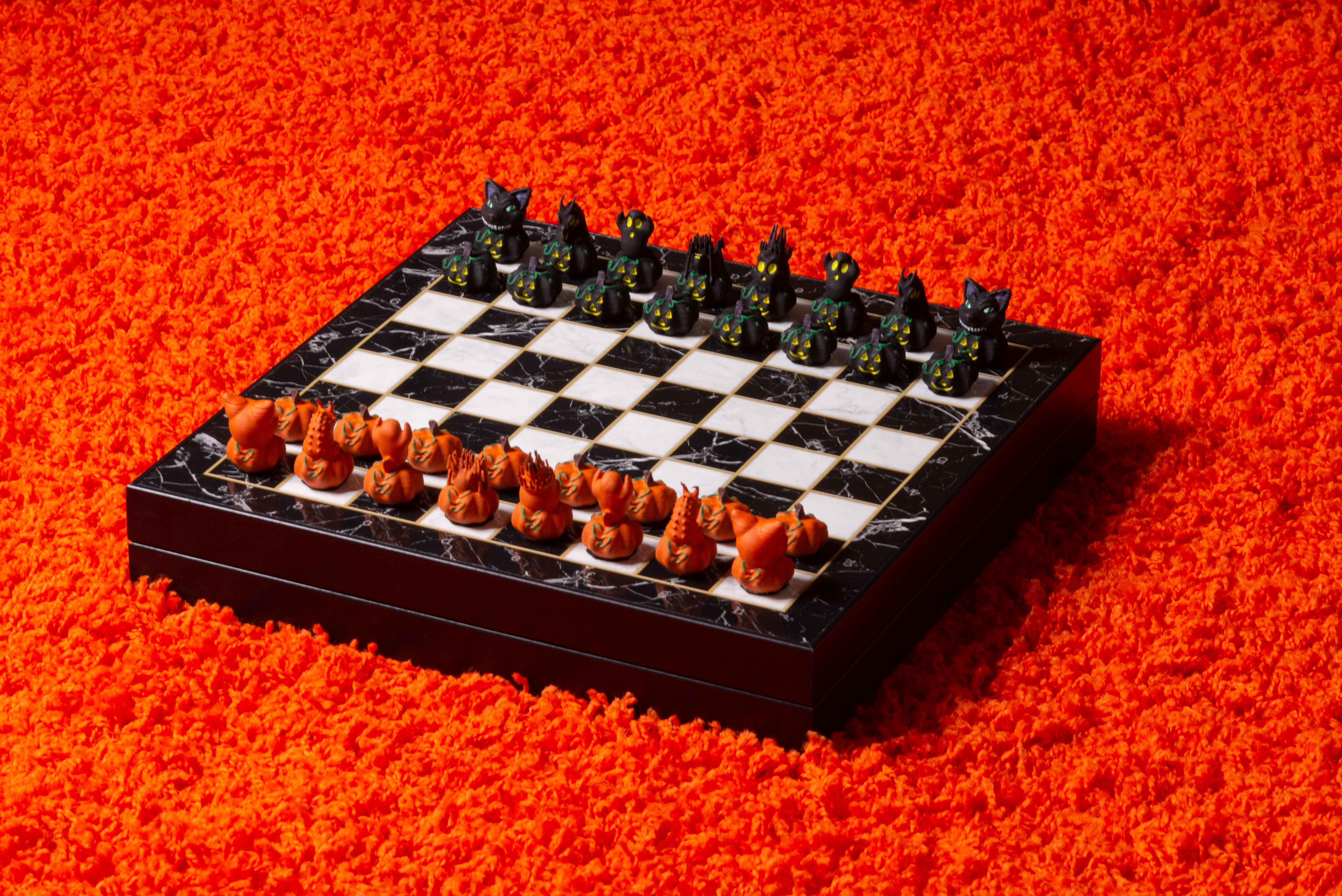



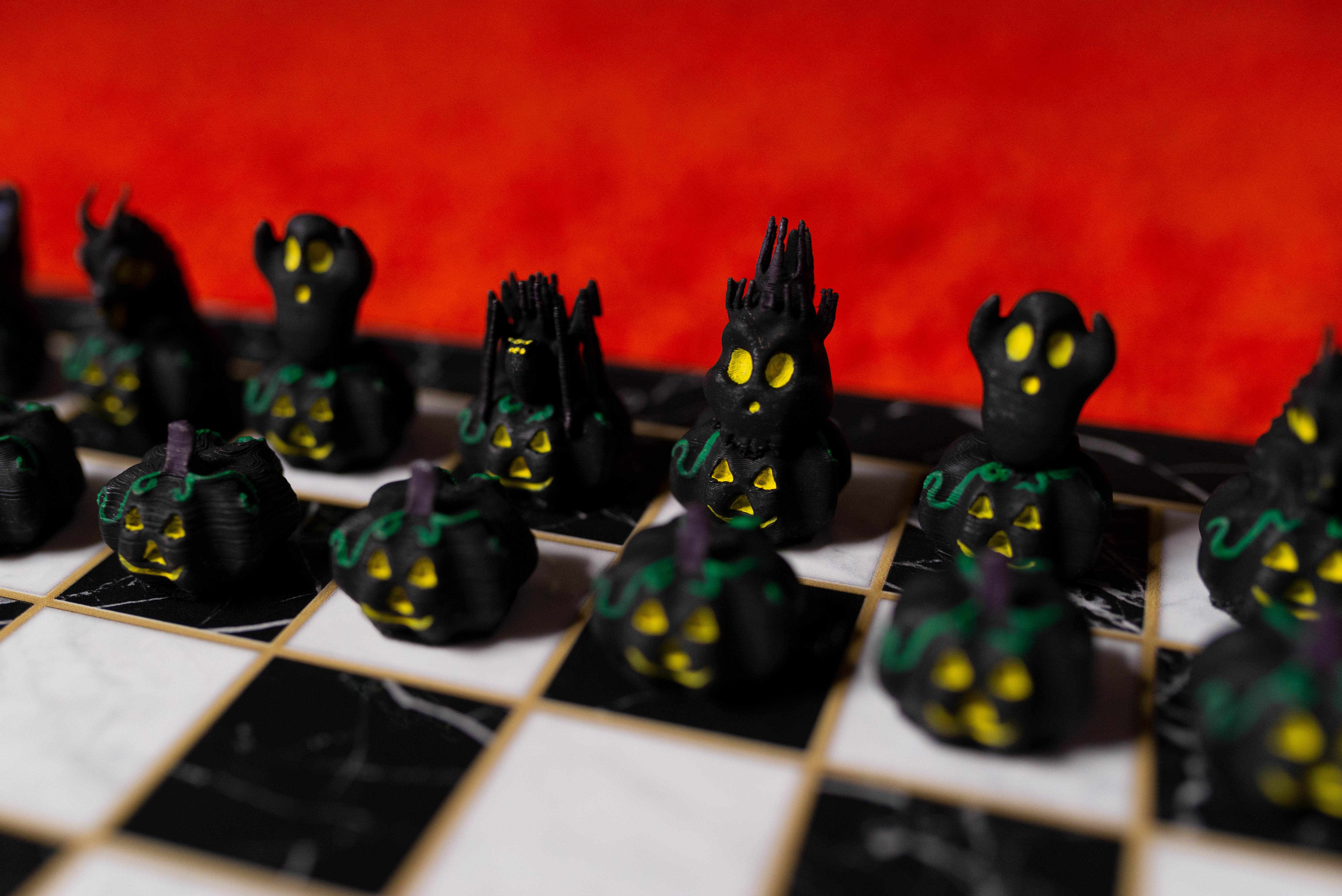
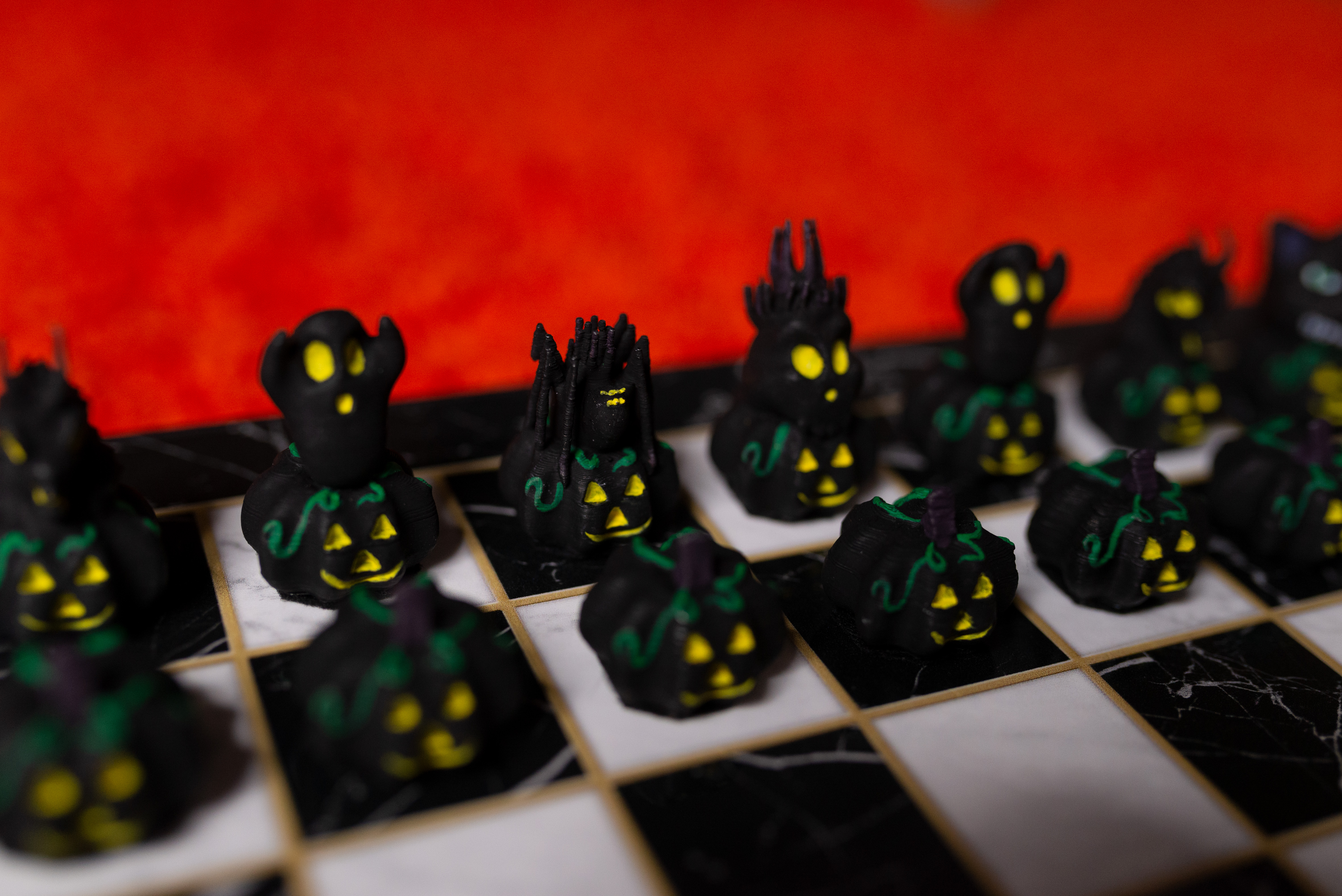



















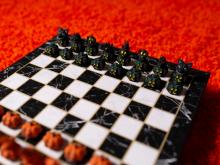



September
September’s featured Chess Set is part of the collection of the World Chess Hall of Fame (WCHOF). Since its creation in 1986, the WCHOF has endeavored to highlight the history and cultural significance of the game of chess. The WCHOF’s collection is diverse and includes sets once owned by legendary players, mass-produced sets with lively pop culture themes, antique ivory sets, travel sets, as well as chess computers. Through these artifacts, the WCHOF illustrates how chess has evolved through its over 1500-year history. This set is part of the museum’s permanent collection.

Maker unknown
Amber Chess Set
1960
King size: 3 ½ in.
Board: 1 ¼ x 16 x 16 ⅛ in.
Amber
Collection of Magnus Carlsen

Maker unknown
Amber Chess Set
1960
King size: 3 ½ in.
Board: 1 ¼ x 16 x 16 ⅛ in.
Amber
Collection of Magnus Carlsen
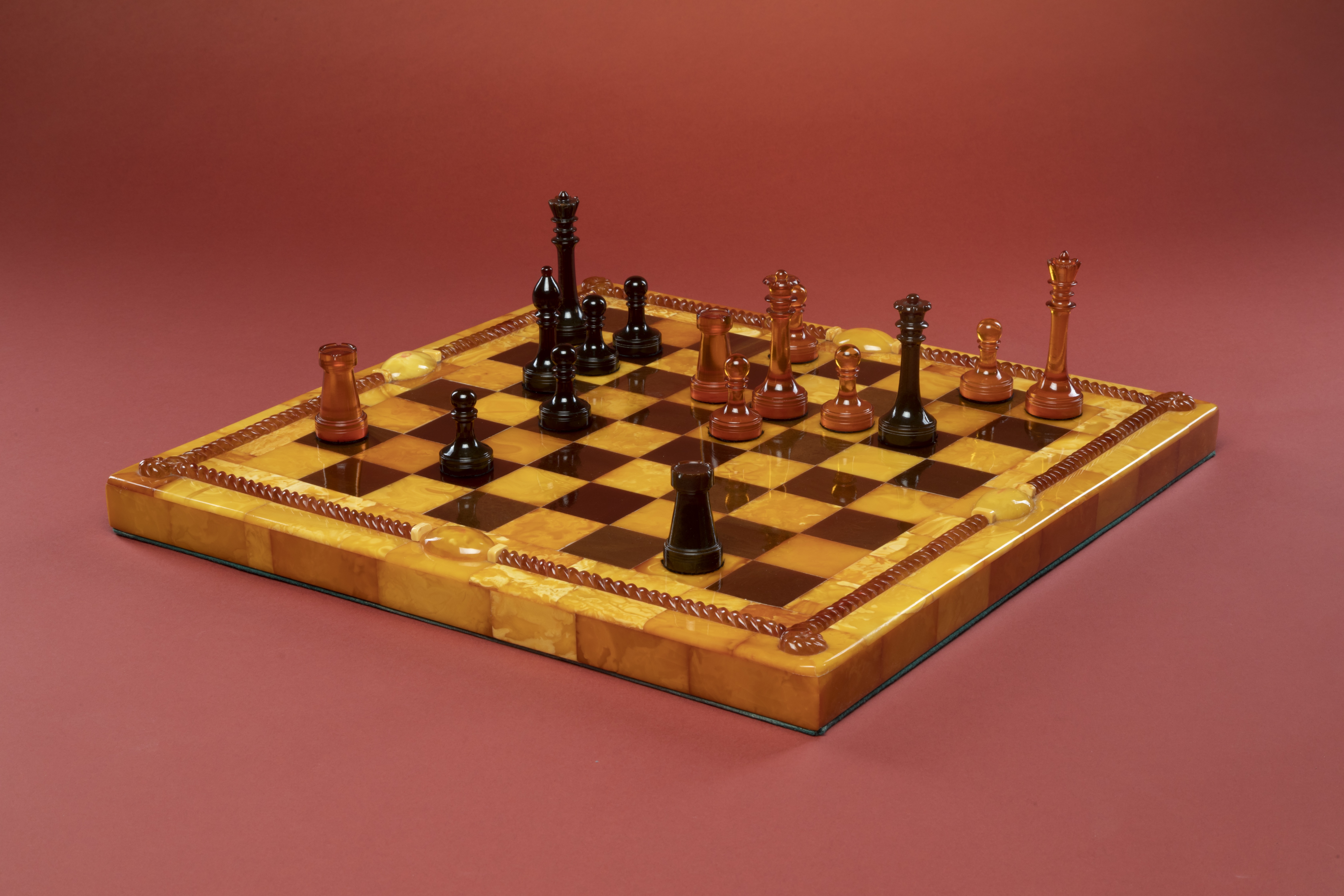
Maker unknown
Amber Chess Set
1960
King size: 3 ½ in.
Board: 1 ¼ x 16 x 16 ⅛ in.
Amber
Collection of Magnus Carlsen

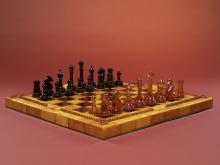

IA Alexander Bakh gifted this elegant amber chess set to World Chess Champion Magnus Carlsen. It was once owned by another world chess champion and prodigy—Mikhail Tal. Tal received the set as a gift following his victory in the 1960 World Chess Championship. The chess set is made from varied shades of amber, ranging from golden yellow to a deep reddish-brown. Amber is fossilized tree resin which is most commonly found in the Baltic Sea region in Europe. The rare material has been used to create decorative art objects for thousands of years.
August
August’s Featured Chess Set is a loan from Ethan Scheulen, who created the elaborate board while a student at Fatima High School in Westphalia, Missouri, and will attend Missouri University of Science and Technology majoring in architectural and civil engineering. Scheulen has a background in woodworking and has created a number of different projects from work tables, to table tops, and a display cabinet made from bamboo plywood.

Ethan Scheulen
Laser Engraved Chessboard
2022
23 in.
Wood
Courtesy of the artis

Ethan Scheulen
Laser Engraved Chessboard
2022
23 in.
Wood
Courtesy of the artis


This chessboard fulfills woodworker Ethan Scheulen’s aspirations to design a sophisticated chessboard using a number of woodworking tools. Of its creation, he states, “I used Adobe Illustrator to design this piece, a Glowforge Laser Engraver to engrave the squares, and a Bob’s CNC Router to create the border. I started with creating mandala designs for each of the dark and light pieces. Then I designed the chess pieces and integrated them into the design. After that, I drew a Celtic knot-inspired border to go around the piece. I used Brazilian Ipe for the dark pieces and hard maple for the light pieces and cherry wood for the border.” The intricate chessboard took 20 hours to complete.
July
July’s featured Chess Set is part of the collection of the World Chess Hall of Fame (WCHOF). Since its creation in 1986, the WCHOF has endeavored to highlight the history and cultural significance of the game of chess. The WCHOF’s collection is diverse and includes sets once owned by legendary players, mass-produced sets with lively pop culture themes, antique ivory sets, travel sets, as well as chess computers. Through these artifacts, the WCHOF illustrates how chess has evolved through its over 1500-year history. This set is part of the museum’s permanent collection.
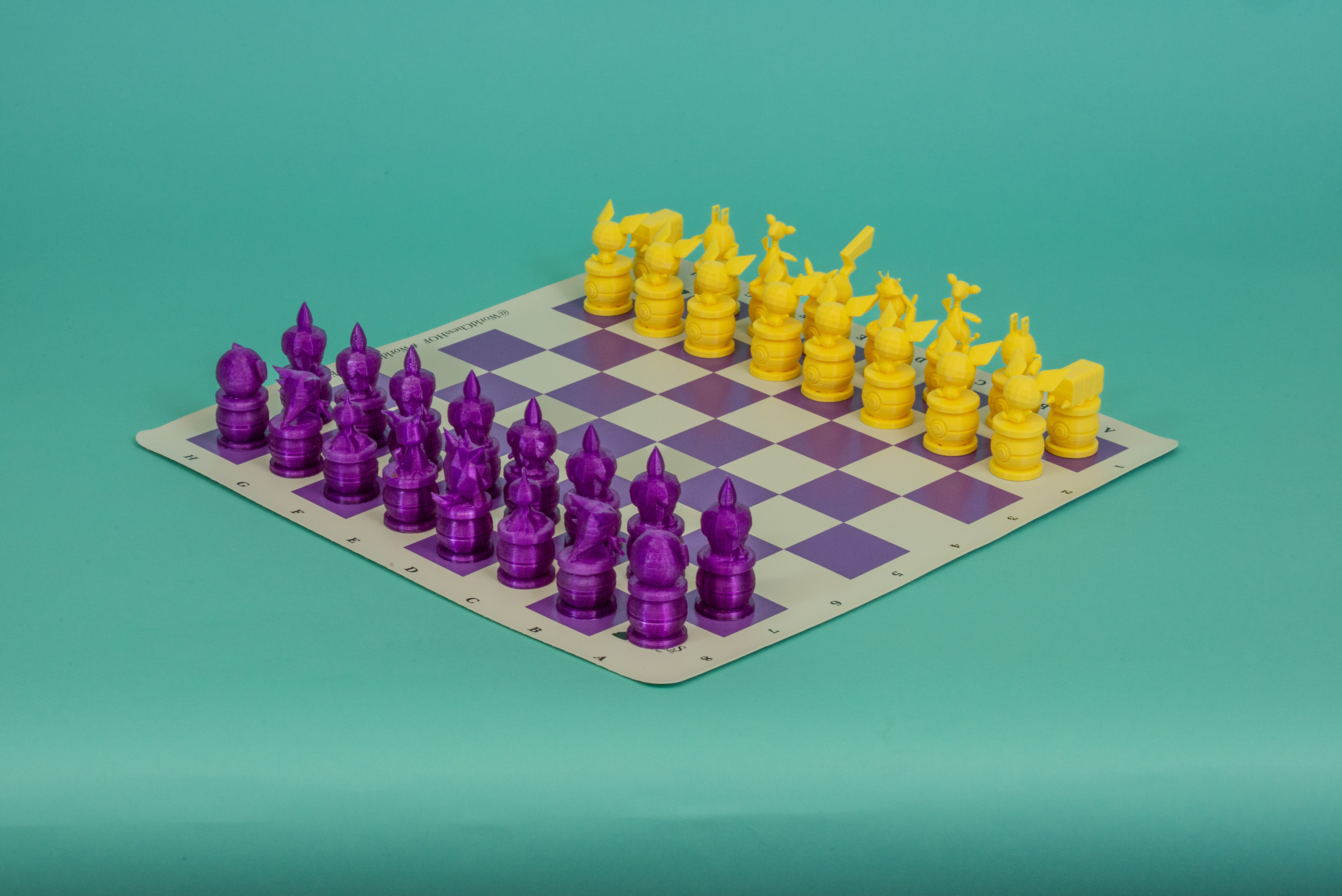
3D4Gamers
Pokémon Chess Set: Electric vs. Ghost
2020
King size: Purple: 3 ¼ in.; Yellow: 3 ½ in.
3D printed plastic
Collection of the World Chess Hall of Fame
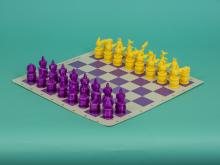
July’s featured chess set is inspired by the video game Pokémon. Each side is modeled after one of the 18 types of pokémon: purple is ghost and yellow is electric. Satoshi Tajiri with the assistance of Ken Sugimori, created the first Pokémon game titled Pocket Monsters Red and Green in Japan in 1996 for the Gameboy. It was later released outside of Japan as Pokémon Red and Blue. The main series of role-playing games has continued on each new generation of Nintendo’s handheld game consoles. The most recently released core series game Pokémon Legends: Arceus, was released on January 28, 2022, for the Nintendo Switch console.
June
June’s Featured Chess Set is part of the collection of the World Chess Hall of Fame (WCHOF). Since its creation in 1986, the WCHOF has endeavored to highlight the history and cultural significance of the game of chess. The WCHOF’s collection is diverse and includes sets once owned by legendary players, mass-produced sets with lively pop culture themes, antique ivory sets, travel sets, as well as chess computers. Through these artifacts, the WCHOF illustrates how chess has evolved through its over 1500-year history. This set is part of the museum’s permanent collection.

Sababa Toys
Sanrio
Hello Kitty Chess Game in Deluxe Collector Tin
2004
King size: 2 in.
Board: 3 5/16 x 12 x 12 in.
PVC and tin
Collection of the World Chess Hall of Fame

Sababa Toys
Sanrio
Hello Kitty Chess Game in Deluxe Collector Tin
2004
King size: 2 in.
Board: 3 5/16 x 12 x 12 in.
PVC and tin
Collection of the World Chess Hall of Fame

Sababa Toys
Sanrio
Hello Kitty Chess Game in Deluxe Collector Tin
2004
King size: 2 in.
Board: 3 5/16 x 12 x 12 in.
PVC and tin
Collection of the World Chess Hall of Fame

Sababa Toys
Sanrio
Hello Kitty Chess Game in Deluxe Collector Tin
2004
King size: 2 in.
Board: 3 5/16 x 12 x 12 in.
PVC and tin
Collection of the World Chess Hall of Fame




Hello Kitty is a global pop icon from Japan and was created in 1974. She is the inspiration for this collection and appears alongside many of her friends. The chess set board is pink and white checkered and the pieces are themed around Hello Kitty and her friends.
May
May’s Featured Chess Set is part of the collection of the World Chess Hall of Fame (WCHOF). Since its creation in 1986, the WCHOF has endeavored to highlight the history and cultural significance of the game of chess. The WCHOF’s collection is diverse and includes sets once owned by legendary players, mass-produced sets with lively pop culture themes, antique ivory sets, travel sets, as well as chess computers. Through these artifacts, the WCHOF illustrates how chess has evolved through its over 1500-year history. This set is part of the museum’s permanent collection.

Liz Fischer of Forest Gnome Studios
Mushroom Chess Set
2022
King size: 3 ¼ in.
Board: 13 ¾ x 13 ¾ in.
Resin, acrylic paint, and fabric
Collection of the World Chess Hall of Fame

Liz Fischer of Forest Gnome Studios
Mushroom Chess Set
2022
King size: 3 ¼ in.
Board: 13 ¾ x 13 ¾ in.
Resin, acrylic paint, and fabric
Collection of the World Chess Hall of Fame
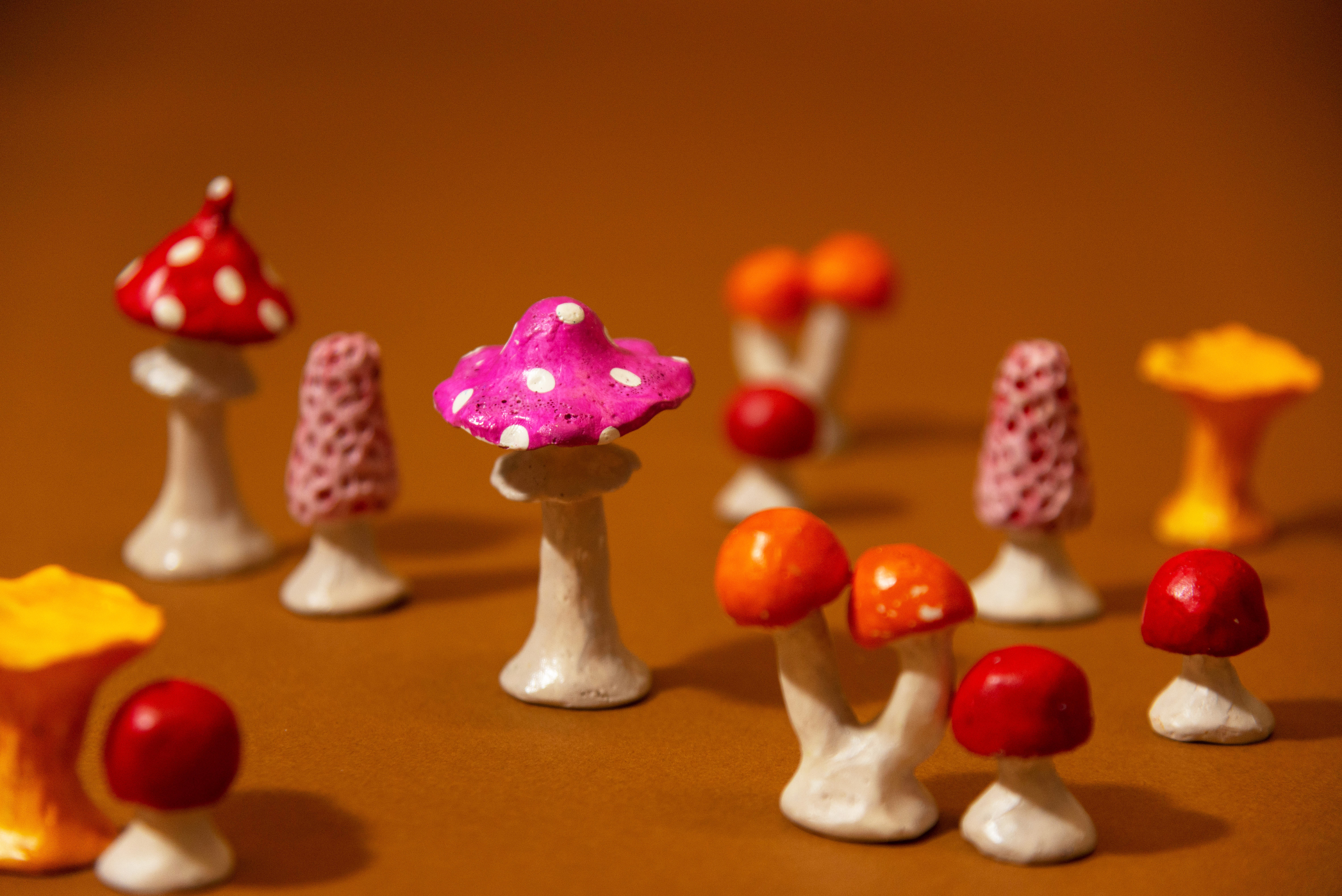
Liz Fischer of Forest Gnome Studios
Mushroom Chess Set
2022
King size: 3 ¼ in.
Board: 13 ¾ x 13 ¾ in.
Resin, acrylic paint, and fabric
Collection of the World Chess Hall of Fame

Liz Fischer of Forest Gnome Studios
Mushroom Chess Set
2022
King size: 3 ¼ in.
Board: 13 ¾ x 13 ¾ in.
Resin, acrylic paint, and fabric
Collection of the World Chess Hall of Fame




This colorful set was created by Etsy seller Liz Fischer of Forest Gnome Studios. Originally from rural Washington but now residing in Texas, Fischer creates handmade game pieces and quilted board games. Her mother was a quilter, and she taught Fischer to sew. Her first project was a quilted checkerboard. After her mother’s passing in 2016, Fischer designed art pieces in her old art studio.
Made of resin pieces cast from hand sculpted models, this chess set resembles common mushroom types found in forests. They include: button mushrooms (pawns), chanterelles (rooks), honey fungus (knights), morels (bishops), toadstools (queens), and amanitas (kings).The two sides represent warm and cool colors. The board is made from upcycled fabric.
April
April’s Featured Chess Set is part of the collection of the World Chess Hall of Fame (WCHOF). Since its creation in 1986, the WCHOF has endeavored to highlight the history and cultural significance of the game of chess. The WCHOF’s collection is diverse and includes sets once owned by legendary players, mass-produced sets with lively pop culture themes, antique ivory sets, travel sets, as well as chess computers. Through these artifacts, the WCHOF illustrates how chess has evolved through its over 1500-year history. This set is part of the museum’s permanent collection

TrixtrDesign
Bunny Chess Set
2021
King size: 2 in.
3D printed plastic
Collection of the World Chess Hall of Fame

TrixtrDesign
Bunny Chess Set
2021
King size: 2 in.
3D printed plastic
Collection of the World Chess Hall of Fame

TrixtrDesign
Bunny Chess Set
2021
King size: 2 in.
3D printed plastic
Collection of the World Chess Hall of Fame



Hopping on to the board are these adorable 3D printed pink and purple chess pieces disguised as bunny rabbits. This chess set provides an egg-cellent opportunity to play the old game with a fun and new shape. The pieces are topped by crowns resembling the tops of traditional chess pieces.
Becca Crooks of TrixtrDesign created this chess set. During the earlier part of the COVID-19 pandemic, Crooks searched for a new hobby and stumbled upon 3D printing chess sets. Crooks’ first creation was a snowman chess set inspired by her mother’s love of snowmen. The set received positive reactions, and Crooks started designing more sets such as the teddy bear, pumpkin, and Christmas tree-themed sets that are a part of the WCHOF’s collection. Crooks sells her creative sets on Etsy.
March
March’s Featured chess set is a loan from Nick Schleicher, the exhibitions manager at the World Chess Hall of Fame. He became interested in chess after seeing his dad, uncles, and grandfather play the game. Schleicher then received this chess computer as a Christmas gift when he was in his early teens. He enjoyed the futuristic aesthetic of the board, and he has fond memories of taking it on road trips. Though this is a chess computer, Schleicher used it mainly like a regular set and often used it to play chess with his cousin.

Saitek
Saitek Kasparov Alchemist
1998
King size: 2 in.
Board: 1 x 10 x 12 ½ in.
Plastic and electronic components
Collection of Nick Schleicher

Saitek
Saitek Kasparov Alchemist
1998
King size: 2 in.
Board: 1 x 10 x 12 ½ in.
Plastic and electronic components
Collection of Nick Schleicher

Saitek
Saitek Kasparov Alchemist
1998
King size: 2 in.
Board: 1 x 10 x 12 ½ in.
Plastic and electronic components
Collection of Nick Schleicher

Saitek
Saitek Kasparov Alchemist
1998
King size: 2 in.
Board: 1 x 10 x 12 ½ in.
Plastic and electronic components
Collection of Nick Schleicher

Saitek
Saitek Kasparov Alchemist
1998
King size: 2 in.
Board: 1 x 10 x 12 ½ in.
Plastic and electronic components
Collection of Nick Schleicher





The Saitek Kasparov Alchemist is named for legendary World Chess Champion Garry Kasparov, who endorsed the talking chess computer. The computer functioned either as a teacher, with numerous levels at varying levels of difficulty, or as a referee during a game with two human players. Eric Winkler, a Swiss technologist, founded Saitek (then called SciCys) in 1979 as a maker of chess computers. In 1994, Saitek was the world’s largest manufacturer of chess computers.
February
February’s Featured Chess Set is a loan from glass artist, Katherine Gardner. Known for her glass artistry at the Saint Louis Renaissance Faire, Gardner created a one of a kind glass chess set that attracts much attention as it becomes luminous when sunlight strikes it. Since age 14, Gardner has been designing glass artwork. She taught herself many unique techniques that she uses today in her glass artistry. Gardner has been invited to the Corning Museum of Art to explain the techniques she used to create this month’s featured set.

Katherine Gardner
Jophiel
2020
King size: 3 ⅛ in.
Board: 14 ¼ x 14 ⅛ in.
Northstar borosilicate glass, Delphi glass, and 60/40 solder
Courtesy of the artist

Katherine Gardner
Jophiel
2020
King size: 3 ⅛ in.
Board: 14 ¼ x 14 ⅛ in.
Northstar borosilicate glass, Delphi glass, and 60/40 solder
Courtesy of the artist

Katherine Gardner
Jophiel
2020
King size: 3 ⅛ in.
Board: 14 ¼ x 14 ⅛ in.
Northstar borosilicate glass, Delphi glass, and 60/40 solder
Courtesy of the artist



Opal, symbolizing love and passion, is fitting for February’s featured chess set. Gardner was curious about how light affects the opal glass and experimented with colors that would compliment the opal in the sunlight. This is because opal glass, when illuminated, mimics the appearance of opal stone. One side of the chess set features two shades of purple and on the other side is a harmonious blue. The board is also made of multicolored glass. Gardner created pieces that have forms similar to traditional chess sets, not wanting to take away from the sophistication and deep intellect of the game.
January
January’s Featured Chess Set is a loan from Vietnam War Veteran Louis Semon, who created the set. During his time in the Air Force in 1968, Semon was stationed in Hurlbelt Field, Florida, waiting for deployment. Of making the set, he says, “While waiting [for deployment] I always wanted to make my own chess set. Fortunately there was a hobby shop on base. I bought the supplies and molds and the tools and equipment and the kilns were available to the service members. Fifty-three years later, I still use the chess set and it’s been on display on my coffee table ever since.”

Louis Semon
Chess Set
1968
King size: 4 in
Board: 17 x 17 in.
Plaster of paris, glaze, and linoleum
Collection of Louis Semon

Louis Semon
Chess Set
1968
King size: 4 in
Board: 17 x 17 in.
Plaster of paris, glaze, and linoleum
Collection of Louis Semon

Louis Semon
Chess Set
1968
King size: 4 in
Board: 17 x 17 in.
Plaster of paris, glaze, and linoleum
Collection of Louis Semon



This hand-crafted ceramic Gothic-style chess set features pieces made from plaster of Paris and glazed green and white. The chessboard is made from green and white linoleum tile that complements the colors of the pieces. Louis Semon created the set using molds designed by Duncan Ceramic Products, Inc. (now iLoveToCreate). Founded by Erma Duncan, an artist with a passion for ceramics, the company was incorporated in 1955. At the time this set was designed, the company sold ceramic products for hobbyists, including molds, and established a national training program for ceramics teachers. Perhaps due to the rising popularity of chess in the United States during the era, the company copyrighted at least six designs for chess sets between 1965 and 1973. Hobbyists could customize the sets with paint or colorful glazes.
